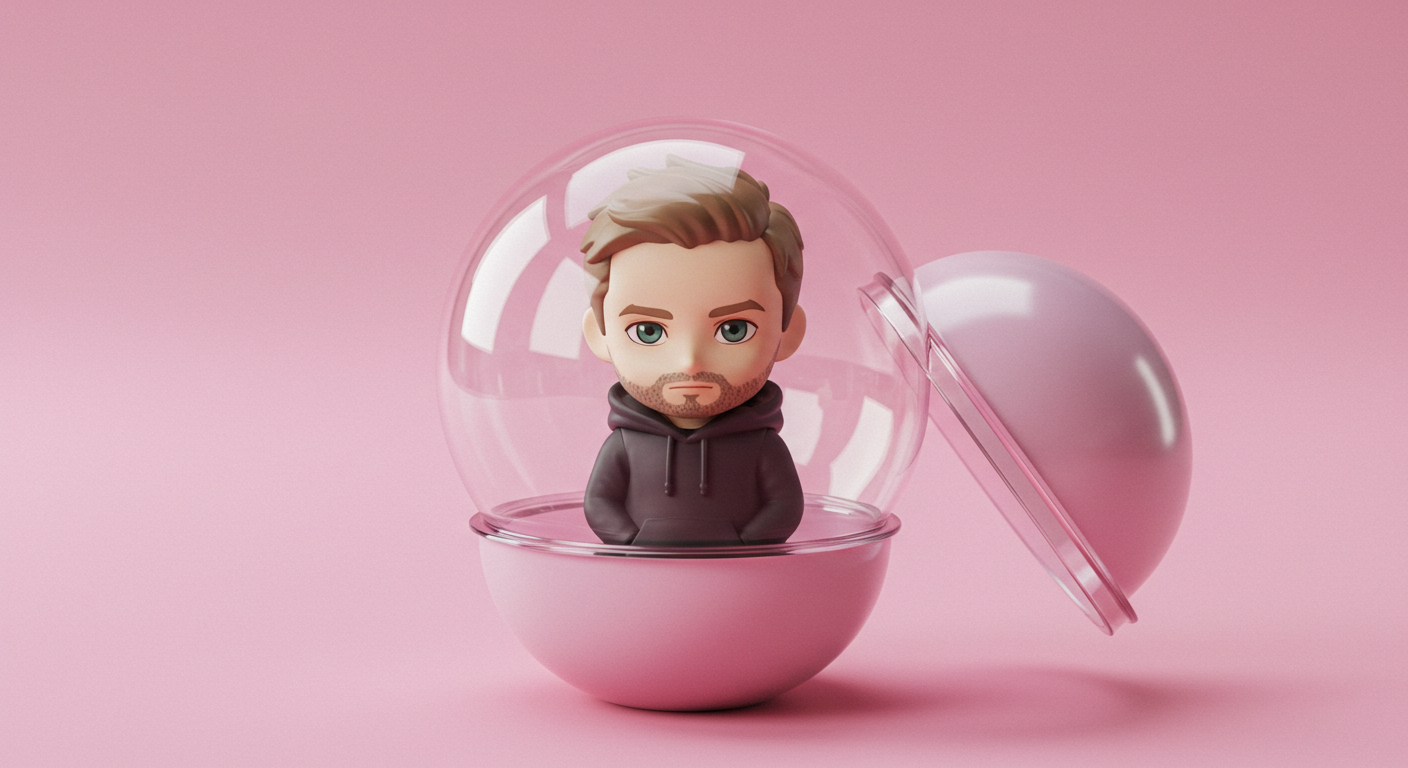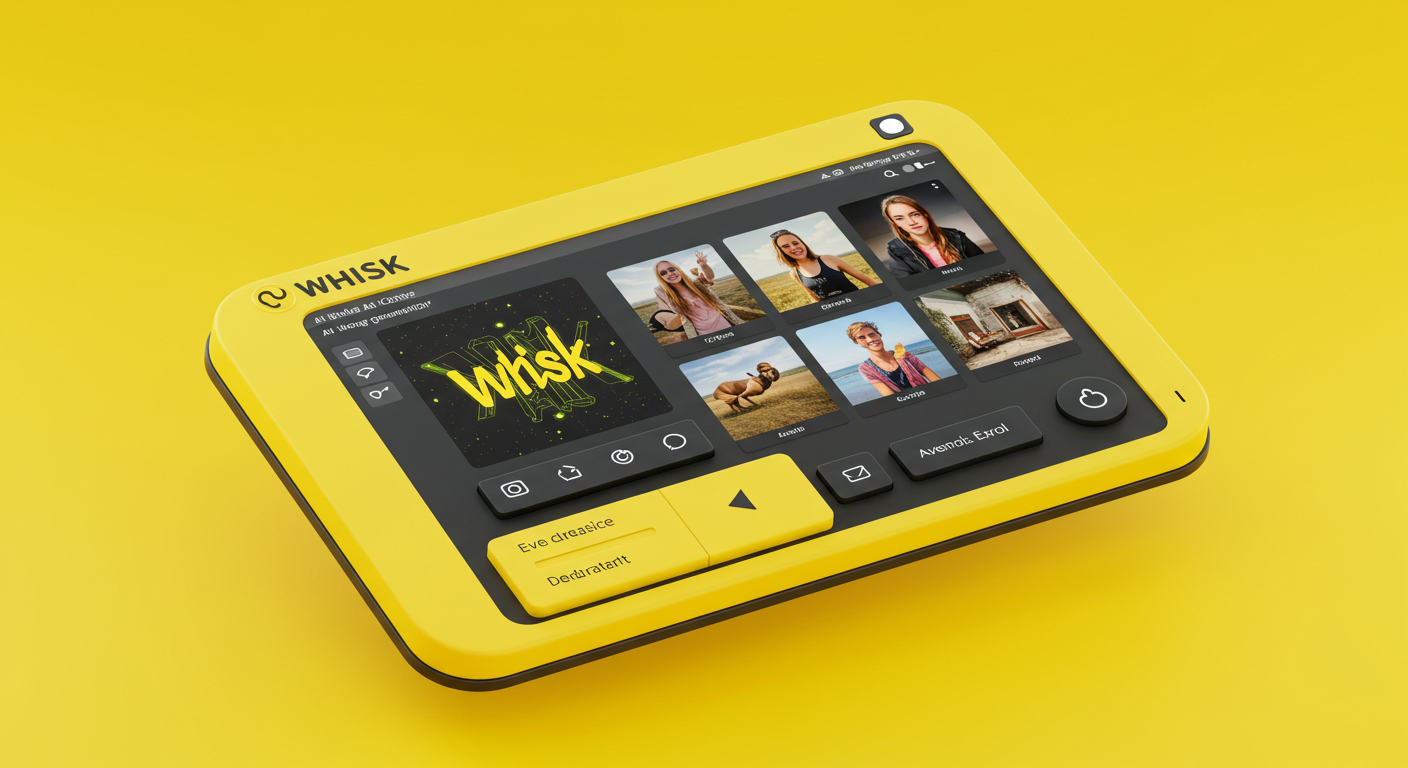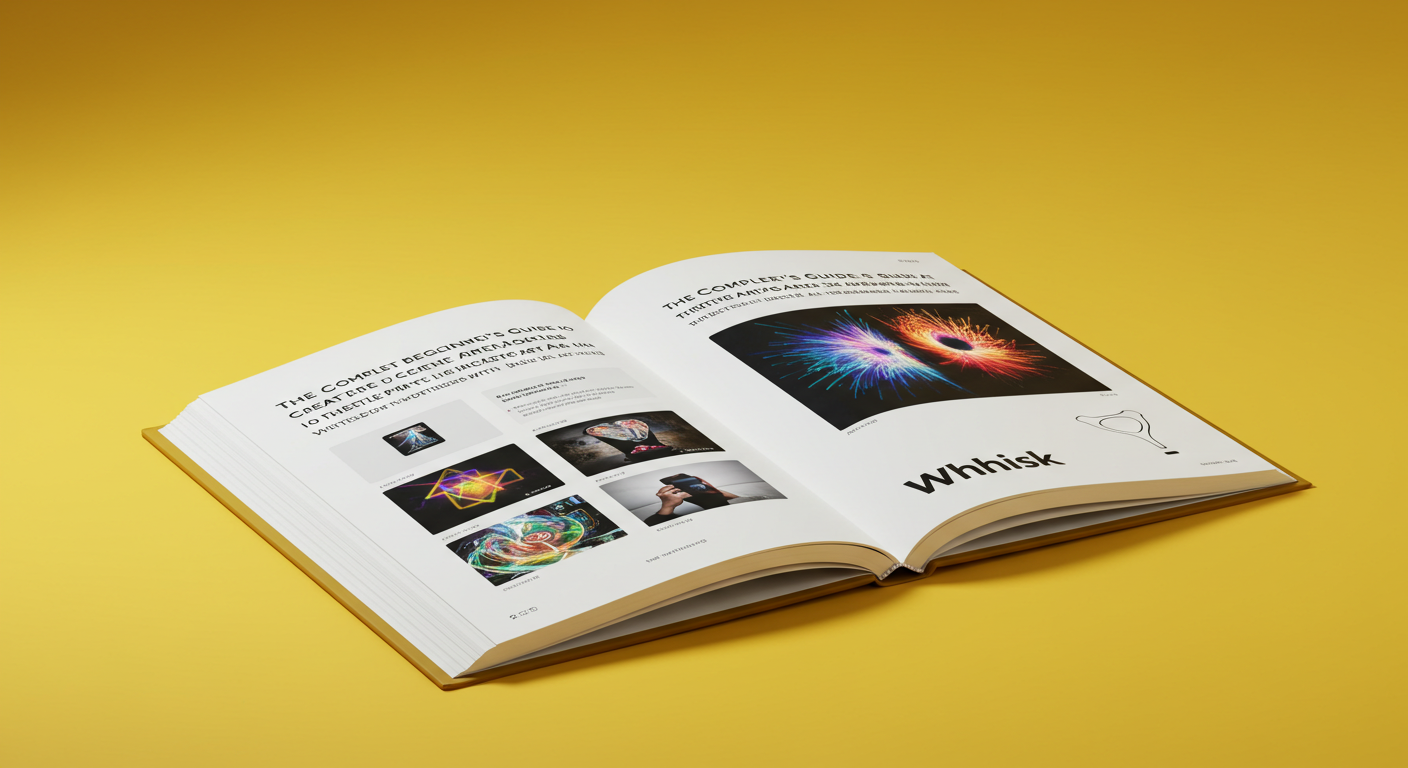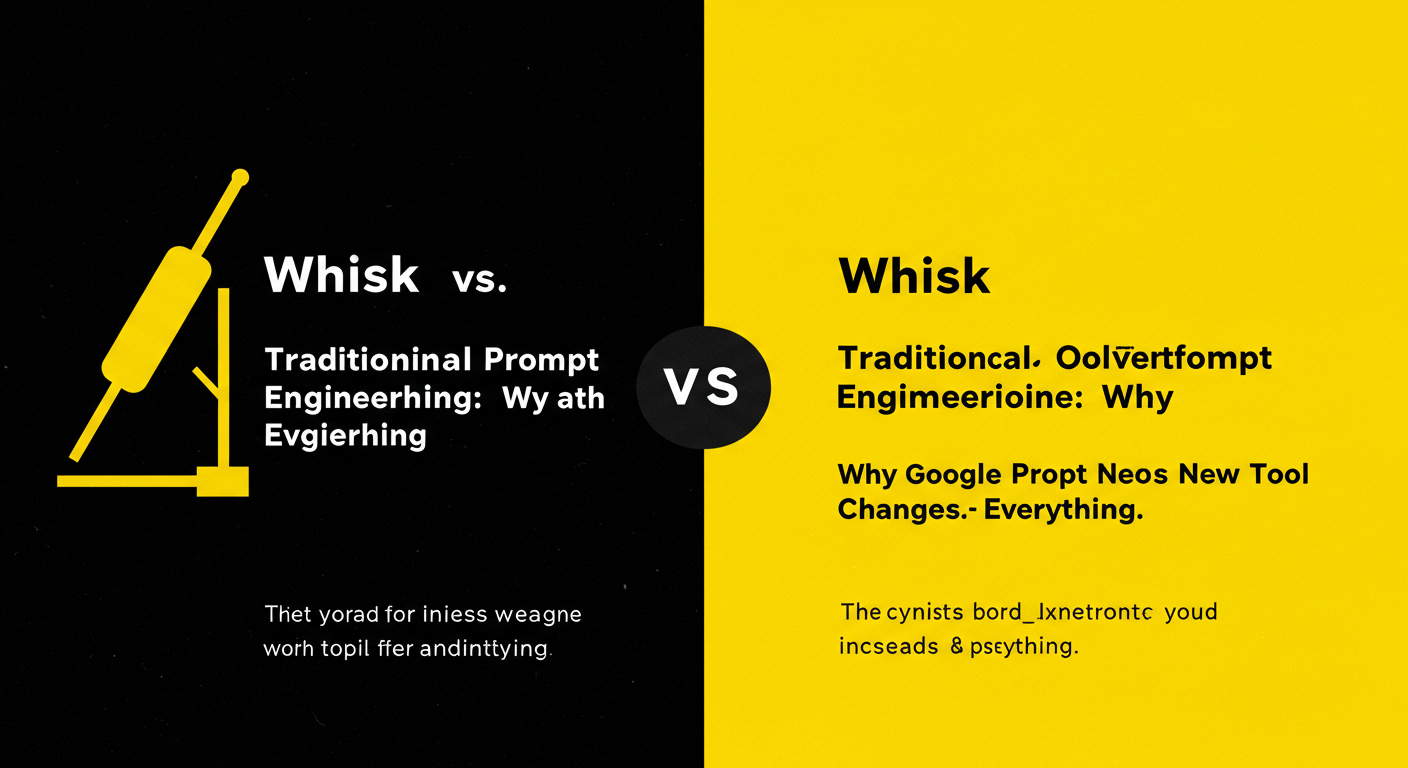Whisk vs. Traditional Prompt Engineering: Why Google's New Tool Changes Everything
Prompt engineering has evolved into something of an art form over the past few years, with dedicated communities sharing complex techniques and formulas for getting the best results from AI image generators. Google Labs' experimental Whisk AI represents a fundamental shift in this landscape, potentially changing how we interact with generative AI tools forever.
The Traditional Prompt Engineering Landscape
Before tools like Whisk, prompt engineering required a significant learning curve. Users needed to understand a variety of techniques:
- Keyword weighting - Using special syntax to emphasize certain elements
- Negative prompting - Explicitly stating what should be avoided
- Style reference - Naming specific artists, movements, or techniques
- Technical parameters - Including render specifications like resolution and detail level
- Compositional directives - Specifying viewpoint, framing, and arrangement
These techniques developed through community experimentation, leading to prompt formats that often looked more like code than natural language. While effective, this created a significant barrier for casual users who couldn't achieve the same quality results as those willing to study prompt engineering principles.
How Whisk AI Transforms the Process
Whisk AI represents a dramatic shift in approach by algorithmically encoding the knowledge of expert prompt engineers. Whisk ai and Veo 3 ai work together as complementary AI tools within Google's creative suite. Here's how it fundamentally changes the process:
Natural Language Input: Rather than requiring users to learn specialized syntax and terminology, Whisk accepts conversational descriptions. This makes the entire process more intuitive and accessible.
Automated Enhancement: The system automatically identifies which elements of a prompt need enhancement and adds appropriate technical details, stylistic references, and compositional guidance.
Educational Approach: By showing users how their simple prompts transform into more effective ones, Whisk actually teaches prompt engineering principles through demonstration rather than requiring upfront learning.
Consistent Quality: Perhaps most importantly
Unlock Your Creative Potential
Whisk AI helps you craft better prompts through intelligent analysis and enhancement techniques.
Prompt Enhancement
Transform basic ideas into detailed, descriptive prompts that generate higher-quality images.
Style: "STICKER"
Enhanced: "A sticker with a white border on a white background, and the style is simple and cartoonish with thick black outlines. The colors are bright and saturated, and the overall look is playful. It looks like a sticker you might find on a water bottle or lunchbox. Make sure to incorporate everything (characters, locations/scenes, elements) WITHIN the sticker. The background is plain white (remove any other background information)."

Style Analysis
Identifies your intended artistic style and enhances it with relevant stylistic descriptors.
Style: "PLUSHIE"
Enhanced: "A photograph of the subject as a chibi plushie made of soft fabric, facing the camera on a white background.The plushie is made of soft, cuddly fabric. They have soft, button eyes and a friendly expression. They'd be a great friend to cuddle with! They are in full frame, centered and uncropped, sitting on a table. The background is plain white (remove any other background information). The lighting is even and soft. This is a perfect picture for a product listing."

Detail Refinement
Adds crucial details to your prompt that dramatically improve image quality and accuracy.
Style: "CAPSULE TOY"
Enhanced: "A close up shot of a small, translucent plastic sphere-shaped container containing a figure inside is shown against a white background. The container is layered in half, with a clear top section and a translucent colored bottom section. The is a kawaii figurine inside of the container.The lighting is even and bright, minimizing shadows. The overall style is clean, simple, and product-focused, with a slightly glossy finish to the plastic. "

See Whisk AI in Action
Explore how different prompt techniques yield dramatically improved results.
Card
Card Style Artistic
Whisk AI recognizes intended artistic styles and enhances prompts with precise stylistic descriptors.
chocolate box
box Visual chocolate Composition
Learn how to direct AI to create balanced, visually appealing compositions through prompt engineering.
Enamel Pin
Enamel Atmospheric Pin Elements
Discover how detailed lighting, mood, and atmospheric cues create emotionally resonant images.
Privacy Policy
Who we are
Our website address is: https://whiskailabs.com. The Official website is labs.google/fx/tools/whisk
Disclaimer
We are enthusiasts and lovers of this incredible tool. On this website we will be exploring its possibilities and sharing latest news about Whisk AI. The “whisk Labs” name is a property of google. We are not affiliated with google. We will never ask for any sensitive information or payments on this web site.
- Media: If you upload images to the website, you should avoid uploading images with embedded location data (EXIF GPS) included. Visitors to the website can download and extract any location data from images on the website.
- Embedded content from other websites: Articles on this site may include embedded content (e.g. videos, images, articles, etc.). Embedded content from other websites behaves in the exact same way as if the visitor has visited the other website.
These websites may collect data about you, use cookies, embed additional third-party tracking, and monitor your interaction with that embedded content, including tracking your interaction with the embedded content if you have an account and are logged in to that website.
- Cookies: If you leave a comment on our site you may opt in to saving your name, email address and website in cookies. These are for your convenience so that you do not have to fill in your details again when you leave another comment. These cookies will last for one year.
If you visit our login page, we will set a temporary cookie to determine if your browser accepts cookies. This cookie contains no personal data and is discarded when you close your browser.
When you log in, we will also set up several cookies to save your login information and your screen display choices. Login cookies last for two days, and screen options cookies last for a year. If you select “Remember Me”, your login will persist for two weeks. If you log out of your account, the login cookies will be removed.
If you edit or publish an article, an additional cookie will be saved in your browser. This cookie includes no personal data and simply indicates the post ID of the article you just edited. It expires after 1 day.
Contact Us
If you have questions or comments about this Privacy Policy, please contact us at: contact@whiskailabs.com
How Whisk AI Works
The Rise of Text-to-Image Technology
In the rapidly evolving landscape of artificial intelligence, text-to-image generation has emerged as one of the most fascinating and accessible applications of machine learning technology. Among the various tools available today, Whisk AI stands out as Google Labs' experimental platform designed to transform how users create visual content. This innovative tool empowers users to generate stunning, customized images simply by providing textual descriptions, effectively bridging the gap between imagination and visualization. What makes Whisk AI particularly remarkable is its focus on enhancing prompt engineering – the art of crafting precise textual instructions that yield desired visual outputs. As businesses and creators increasingly seek distinctive visual assets for branding, marketing, and creative projects, Whisk AI offers a powerful solution by democratizing image generation capabilities previously available only to those with extensive design expertise. The platform's unique approach to visual styling and customization positions it as a valuable resource in the creative toolkit of designers, marketers, content creators, and casual users alike, fundamentally transforming the creative workflow and expanding the possibilities for visual expression in the digital age.
Understanding Whisk AI's Core Technology
At its core, Whisk AI operates on sophisticated deep learning algorithms specifically designed for understanding and interpreting natural language in relation to visual elements. The foundation of Whisk AI rests upon diffusion models, a class of generative AI systems that gradually transform random noise into coherent images by applying a series of refinements guided by textual descriptions. These models have been trained on vast datasets of image-text pairs, enabling them to grasp complex relationships between verbal descriptions and visual representations. What distinguishes Whisk AI from other text-to-image generators is its specialized focus on styled outputs and prompt enhancement. The system utilizes transformer-based neural networks similar to those in powering language models, but optimized for cross-modal understanding between textual and visual domains. When a user inputs a text prompt, Whisk AI parses this information through multiple processing layers that extract semantic meaning, identify key visual elements, recognize stylistic indicators, and determine compositional attributes. This multi-layered understanding allows the system to generate images that not only contain the requested content but also adhere to specified aesthetic parameters. Additionally, Whisk AI employs techniques like attention mechanisms that help it prioritize different aspects of the prompt based on their relative importance to the desired output.
A User's Journey Through Whisk AI
The Whisk AI interface presents a thoughtfully designed user experience that balances simplicity with powerful customization options. Upon accessing the platform, users are immediately greeted with a clean, yellow-themed workspace dominated by three primary sections: Style, Subject, and the resulting output. The intuitive layout guides users through a logical creation process that begins with selecting a predefined style from options including Sticker, Plushie, Capsule Toy, Enamel Pin, Chocolate Box, and Card. Each style selection fundamentally alters how the final image will be rendered, affecting everything from dimensionality and texture to lighting and overall aesthetic approach. After establishing the style foundation, users proceed to the Subject section where they can either input descriptive text or upload reference images. This dual-input capability provides flexibility, allowing users to use visual references when words alone might be insufficient to convey their vision. The platform's responsive design adapts to various devices, maintaining functionality across desktop and mobile experiences. Additional features like the "ADD MORE" button enable users to incorporate supplementary elements such as scene settings or additional styling parameters, expanding creative possibilities. The interface employs visual cues including dashed borders for upload areas and clear iconography to facilitate intuitive navigation. As users make selections and provide inputs, the platform provides real-time feedback, creating a dynamic and interactive experience that makes sophisticated AI technology accessible even to those with limited technical expertise.
Customizing Your Visual Aesthetic
The style selection process represents one of Whisk AI's most distinctive features, offering users precise control over the aesthetic direction of their generated images. The platform currently provides six default styles – Sticker, Plushie, Capsule Toy, Enamel Pin, Chocolate Box, and Card – each meticulously developed to produce consistently recognizable visual outcomes. When a user selects "Plushie," for instance, the system activates specialized parameters that influence how the subject will be rendered, applying characteristic soft textures, rounded forms, simplified facial features, and the distinctive proportions associated with plush toys. This style-based approach effectively addresses one of the most significant challenges in text-to-image generation: maintaining stylistic consistency across different subjects. The style selection serves as a high-level instruction set that guides numerous technical aspects of the image generation process, including lighting models, texture application, edge treatment, color palettes, and dimensional representation. Beyond the default options, Whisk AI allows users to create custom styles by combining elements of existing styles or by providing reference images that exemplify their desired aesthetic. The platform analyzes these references to extract stylistic elements that can be applied to new subjects. Advanced users can further refine style parameters by specifying additional attributes like "minimalist," "vintage," or "futuristic" to create more nuanced visual outcomes. This granular control over style enables creators to maintain brand consistency across multiple images or to experiment with novel visual approaches while maintaining a coherent aesthetic foundation.
From Text Prompts to Visual Elements
The subject definition phase is where users communicate the central content of their desired image, and Whisk AI offers multiple pathways to achieve this crucial step. The primary method involves entering descriptive text that specifies what should appear in the image – anything from simple objects like "red apple" to complex scenes like "Victorian-era library with leather-bound books and a crackling fireplace." The platform's natural language processing capabilities analyze these descriptions to identify key entities, their attributes, and relationships, which then inform the generation process. For subjects that are difficult to describe precisely with words, Whisk AI provides an image upload option, allowing users to supply visual references. When an image is uploaded, the system's computer vision algorithms analyze its content, extracting information about shapes, colors, textures, and composition that can be integrated into the new creation. This reference-based approach is particularly valuable when working with specific characters, unique objects, or complex visual concepts. The platform excels at understanding contextual relationships between elements in multi-part descriptions, allowing for sophisticated compositions where multiple subjects interact. Notably, Whisk AI demonstrates impressive capability in handling abstract concepts and emotional descriptors, translating terms like "serene," "chaotic," or "mysterious" into appropriate visual treatments. For optimal results, users are encouraged to be specific in their subject descriptions, including details about physical characteristics, colors, positioning, and even the emotional quality or mood of the subject. This attention to detail in the subject definition phase significantly influences the accuracy and satisfaction with the final generated image.
How Whisk AI Combines Style and Subject
The fusion process represents the technological heart of Whisk AI, where the selected style and defined subject converge to create a cohesive visual output. This complex computational operation involves multiple AI subsystems working in concert to ensure that the subject is faithfully represented while being authentically transformed according to the chosen style. When a user initiates generation, Whisk AI first constructs a comprehensive internal representation that encompasses both the semantic content of the subject and the aesthetic parameters of the selected style. This representation guides the diffusion process, where the system gradually refines a random noise pattern into a coherent image through thousands of incremental adjustments. During this refinement, specialized neural networks continuously evaluate the emerging image against both style and subject criteria, making precise modifications to bring the output closer to the desired result. The system employs sophisticated balancing mechanisms to resolve potential conflicts between subject fidelity and style adherence – determining, for example, how much to simplify a complex subject when rendering it as a sticker or how to maintain recognizable character features when transforming them into plushie form. Advanced attention layers within the neural architecture ensure that critical identifying features of the subject receive appropriate emphasis, preserving essential visual identity even through significant stylistic transformation. Throughout the fusion process, Whisk AI applies contextual understanding to make intelligent decisions about color harmonization, spatial arrangement, proportional adjustments, and detail prioritization. This ensures that the final output maintains internal consistency while successfully merging the distinctive characteristics of both the chosen style and the specified subject.
The Technical Architecture of Whisk AI
Behind Whisk AI's user-friendly interface lies a sophisticated technical architecture comprised of multiple specialized AI systems working in concert. The platform is built upon a foundation of transformer-based neural networks that facilitate cross-modal understanding between textual and visual domains. When processing begins, the text understanding module – likely based on evolved BERT or T5 model architectures – analyzes user prompts to extract semantic meaning, identifying entities, attributes, relationships, and stylistic indicators. This textual information is then converted into a latent representation that serves as guidance for the image generation process. The core generative component employs a diffusion model architecture, conceptually similar to those used in systems like Stable Diffusion but with Google-specific optimizations for style consistency and prompt adherence. This model operates by gradually denoising a random pattern through thousands of iterative steps, with each step guided by the latent representation derived from the user's input. Supporting these primary components are specialized modules for style encoding, which maintain libraries of stylistic patterns that can be consistently applied across different subjects. Advanced computer vision algorithms handle reference image analysis when users upload visual examples, extracting key features that can be incorporated into new generations. The entire system likely relies on Google's distributed computing infrastructure, utilizing specialized Tensor Processing Units (TPUs) optimized for the complex matrix operations underlying neural network computations. This hardware acceleration enables the platform to generate high-quality images with reasonable latency despite the computational intensity of the process. Regular model updates and fine-tuning based on user interactions and feedback continually improve the system's performance, expanding its capabilities and refining its outputs over time.
Exploring Whisk AI's Default Styles
Each of Whisk AI's default styles represents a carefully developed aesthetic approach with distinctive visual characteristics that transform subjects in predictable yet creatively interesting ways. The "Sticker" style produces flat, graphic representations with bold outlines, simplified details, and vibrant colors optimized for high visibility and instant recognition – perfect for digital stickers, physical decals, or social media elements. In contrast, the "Plushie" style generates soft, huggable interpretations of subjects with rounded forms, textile-like textures, and the characteristic proportions of stuffed toys, as evidenced in the example of the plushie figure wearing a black hoodie shown in the third image. The "Capsule Toy" option creates miniaturized, collectible-style renderings with glossy surfaces, simplified features, and the distinctive proportions associated with gacha or vending machine toys. For a more elegant approach, the "Enamel Pin" style produces designs with the characteristic hard edges, metallic finishes, and color constraints typical of enamel pin manufacturing, making it ideal for merchandise design visualization. The "Chocolate Box" style applies a confectionery aesthetic with rich textures, ornate detailing, and the distinctive visual language of premium chocolate packaging. Finally, the "Card" style generates illustrations suitable for greeting cards, playing cards, or collectible card games, with balanced compositions and appropriate negative space for potential text integration. Each style consistently applies its unique visual characteristics regardless of subject matter, ensuring that diverse subjects – from landscapes to portraits to abstract concepts – receive cohesive treatment when rendered within the same style category. This stylistic reliability makes Whisk AI particularly valuable for projects requiring visual consistency across multiple generated images.
How Whisk AI Improves User Descriptions
One of Whisk AI's most valuable features is its ability to enhance and refine user prompts, effectively serving as a collaborative partner in the creative process rather than a mere execution tool. When users provide basic or ambiguous descriptions, Whisk AI employs sophisticated language understanding to infer additional details that might improve the resulting image. This prompt enhancement occurs through several mechanisms. First, the system identifies gaps in descriptions – such as missing color information, undefined backgrounds, or unspecified perspectives – and applies contextually appropriate defaults based on its training data and the selected style. Second, it recognizes opportunities to add stylistic coherence, ensuring that different elements within a complex prompt receive harmonious treatment. Third, it detects potential technical challenges in the user's description and subtly adjusts parameters to produce more satisfactory results. For example, if a user requests a subject with extremely intricate details that would be lost in a simplified style like "Sticker," the system intelligently preserves the most important visual identifiers while appropriately simplifying secondary elements. This enhancement process manifests differently across various styles – in "Plushie" mode, the system might automatically soften angular features and add characteristic stitching patterns, while in "Enamel Pin" style, it might adjust color palettes to work within the constraints of typical enamel manufacturing. Throughout this process, Whisk AI maintains fidelity to the user's core intent while drawing upon its vast training in visual aesthetics to elevate the final output beyond what might have been achieved with the literal interpretation of the initial prompt.
Creating a Character Plushie with Whisk AI
The third image provided offers a perfect case study of Whisk AI's capabilities, demonstrating how the platform transforms a reference image into a styled creation. In this example, a reference image was provided, and the "Plushie" style was selected, resulting in a charming plush toy representation of a character with short brown hair, blue eyes, facial hair, and a black hoodie. This transformation illustrates several key aspects of Whisk AI's processing approach. First, the system successfully identified the essential characteristic features needed to maintain recognizability – the distinctive facial structure, eye color, hair style, and clothing choice. Second, it applied the defining elements of plushie aesthetics, including the softened facial features, simplified body proportions with a larger head relative to the body, textile-appropriate textures, and the characteristic sitting posture typical of plush toys. Third, it made intelligent decisions about which details to preserve and which to simplify – maintaining the hoodie's front pocket and drawstrings as key identifying elements while reducing the complexity of the facial features to match plushie manufacturing constraints. The result demonstrates Whisk AI's sophisticated understanding of both the reference subject and the target style. This type of transformation has practical applications across numerous fields – toy designers could rapidly prototype concepts, marketing teams could visualize branded mascots in merchandise form, content creators could develop character merchandise concepts, and fans could envision favorite characters in collectible formats. The speed and accuracy with which Whisk AI performs these transformations significantly reduces the time and skill barriers that would traditionally be associated with such creative visualizations.
Industries Benefiting from Whisk AI
Whisk AI's unique approach to styled image generation offers value across numerous professional domains. In the merchandise and product design sector, the platform enables rapid prototyping of product concepts, allowing designers to visualize how characters or logos might translate into physical items like plush toys, pins, or stickers before investing in manufacturing. Marketing professionals can leverage Whisk AI to create consistent visual assets across campaigns, quickly generating styled illustrations for social media, advertisements, and promotional materials while maintaining brand coherence. For content creators, including YouTubers, streamers, and social media influencers, the tool provides an accessible way to develop custom emotes, subscriber badges, channel art, and merchandise concepts without requiring advanced design skills or expensive commissioning. The entertainment industry benefits from Whisk AI's ability to rapidly visualize character concepts in different merchandise formats, supporting licensing decisions and product development for film, television, and gaming properties. Educational institutions can use the platform to create engaging visual materials, transforming complex concepts into approachable, styled illustrations that capture student attention. Small businesses with limited design budgets find particular value in Whisk AI's ability to generate professional-quality visual assets quickly and affordably, supporting everything from logo variants to product photography alternatives. The platform also serves the crafting community, providing inspiration and templates for projects ranging from embroidery patterns to custom sticker production. Across these diverse applications, Whisk AI's combination of user-friendly interface and sophisticated styling capabilities removes traditional barriers to visual content creation, enabling professionals from non-design backgrounds to produce compelling visual assets that previously would have required specialized skills or significant outsourcing costs.
How Whisk AI Ensures Consistent Results
Ensuring consistent, high-quality outputs regardless of input complexity is a primary focus of Whisk AI's technical design. The platform employs multiple quality control mechanisms to maintain reliable performance across diverse use cases. At the foundation of this quality assurance approach is extensive model pre-training on carefully curated datasets that establish baseline standards for each supported style. This training instills the system with robust pattern recognition capabilities that allow it to maintain stylistic integrity even when processing unfamiliar subjects. During image generation, multi-stage evaluation processes continuously assess the emerging output against both technical and aesthetic criteria, making refinements to address issues like proportional inconsistencies, texture irregularities, or style deviations. To handle edge cases and unusual requests, Whisk AI implements sophisticated fallback mechanisms that gracefully simplify overly complex elements while preserving essential characteristics and overall quality. The platform's style-specific optimization ensures that each visual treatment receives specialized processing appropriate to its unique requirements – for example, applying different quality standards to the flat, vector-like requirements of the "Sticker" style versus the dimensional complexity of the "Plushie" style. Google's commitment to continuous improvement means that user interactions and feedback constantly inform system refinements, with machine learning algorithms identifying patterns in successful generations to improve future outputs. This focus on quality control extends to computational resource management, where the system balances generation speed against output refinement to deliver images that meet quality thresholds within reasonable timeframes. The result is a platform that professionals can rely on for consistent results, making Whisk AI suitable for production environments where output predictability is essential.
Understanding Whisk AI's Approach
As with any AI system processing user inputs, privacy considerations form an important aspect of Whisk AI's operational framework. Google Labs has implemented several measures to address potential privacy concerns while maintaining the functionality and performance of the platform. When users upload reference images or enter textual descriptions, this data is processed in accordance with Google's privacy policies, which typically include provisions for temporary storage necessary for service provision while limiting long-term retention of user-specific information. The platform likely employs data isolation techniques that separate personally identifiable information from content data, reducing privacy risks while still enabling system improvements through anonymized learning. For enterprise users with heightened data sensitivity requirements, Google typically offers additional controls and compliance certifications, though specific options for Whisk AI would depend on its current development and deployment status as an experimental tool. It's worth noting that images generated through the platform may be subject to different privacy and ownership considerations than user-uploaded reference materials, with specific terms outlined in the service agreement. Users with particular concerns about proprietary or sensitive reference materials should review the applicable terms of service, which define how uploaded content may be used for system training and improvement. While specific details of Whisk AI's privacy architecture are not publicly documented in detail, Google's established practices in AI services typically include encryption for data in transit, access controls for stored information, and compliance with regional data protection regulations like GDPR where applicable. For the most current and authoritative information about Whisk AI's privacy practices, users should consult Google's official documentation and privacy policies, which evolve alongside the platform's development.
The Evolution of Whisk AI Technology
As an experimental tool from Google Labs, Whisk AI represents an early stage in what promises to be a significant evolutionary path for styled text-to-image technology. Several promising directions for future development can be anticipated based on current trends in AI research and Google's established innovation patterns. In the near term, we can expect expansion of the style library beyond the current six options, potentially including user-requested styles and more specialized visual treatments for specific industries or applications. Improvements in customization capabilities will likely allow for more granular control over specific style attributes, enabling users to adjust parameters like texture density, color saturation, or dimensional properties within a chosen style. Technical advancements in the underlying models will progressively improve image quality, with particular focus on challenging aspects like text rendering, complex textures, and anatomical accuracy when appropriate to the style. Integration with other Google services presents compelling possibilities – from incorporating Google Fonts for improved text handling to potential connections with Google's 3D and AR technologies for dimensional extensions of styled content. As the technology matures, we might see the introduction of animation capabilities, allowing users to bring their styled creations to life with simple movements or transitions. Enterprise-focused enhancements could include team collaboration features, brand asset management, and advanced customization options for commercial users. The continued advancement of Google's multimodal AI systems suggests that Whisk AI may eventually offer even more sophisticated understanding of complex prompts, including emotional nuance and cultural context. While speculative, it's also reasonable to anticipate eventual integration with physical production services, potentially allowing users to order actual manufactured versions of their digital creations directly through the platform. As with all Google experimental projects, the specific development trajectory will be shaped by user engagement, technical breakthroughs, and strategic priorities, making Whisk AI an evolving canvas for innovation in visual content creation.
Mastering Whisk AI for Creative Excellence
Mastering Whisk AIfor Creative Excellence
Whisk AI represents a significant advancement in the democratization of visual content creation, offering a sophisticated yet accessible approach to styled image generation that bridges the gap between imagination and realization. By combining powerful AI technology with an intuitive interface organized around the fundamental concepts of style and subject, the platform empowers users across experience levels to produce visually compelling content without extensive technical or artistic training. The six default styles – Sticker, Plushie, Capsule Toy, Enamel Pin, Chocolate Box, and Card – provide versatile starting points for creative exploration, while the flexible subject definition options accommodate everything from simple text descriptions to complex visual references. As demonstrated by the plushie example, Whisk AI excels at maintaining the essential character of subjects while transforming them according to consistent stylistic parameters, making it particularly valuable for brand asset development, merchandise visualization, and creative content production. For users seeking to maximize their results with the platform, several best practices emerge: being specific in subject descriptions, understanding the characteristic elements of each style, utilizing reference images when appropriate, and approaching the process with an experimental mindset that leverages the system's prompt enhancement capabilities. As Google continues to refine this experimental tool, users can anticipate expanded creative possibilities through additional styles, enhanced customization options, and improved technical performance. Whether employed by professional designers seeking rapid prototyping capabilities, marketing teams developing branded assets, content creators building community engagement materials, or casual users exploring creative expression, Whisk AI stands as a powerful example of how artificial intelligence can extend human creative potential in the visual domain, making sophisticated image creation more accessible, efficient, and enjoyable than ever before.

Prompt Analysis
Whisk AI uses natural language processing to understand your initial prompt's core concepts, subjects, and implied style.
The system identifies missing elements that would improve image generation quality and prepare to enhance your description.
Detail Enhancement
Based on the analysis, Whisk adds specific details related to visual style, lighting, composition, and contextual elements.
The enhancement process draws from a vast knowledge base of effective prompt techniques and artistic terminology.
Google Labs Approach
As an experimental Google Labs tool, Whisk AI is continuously improving through user feedback and research developments.
The system maintains user privacy while learning from anonymized patterns in prompt effectiveness across different image generation models.
 Whisk Ai
Whisk Ai











